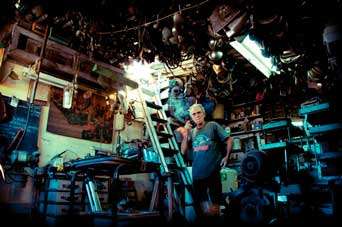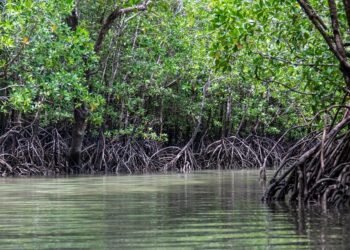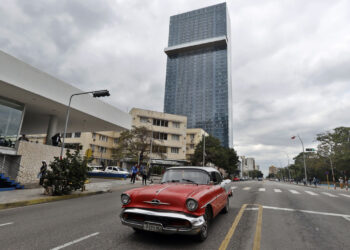Photos: Max Cucchi
Salsa and cigars, Martí and classic cars: from La Rampa to the Plaza de la Revolución, Havana’s streets are iconic incarnate. And while things are changing fast in the Cuban capital, (these days you’re as likely to see Ed Hardy tees and iPhones as ’55 Buicks and horse carts), a group of passionate Cubans are keeping history alive and moving in style. Proudly loud – the louder the better, like most things in Cuba – with sirens as shrill as an ambulance racing to the rescue, you’ll hear them before you see them and feel the street trembling beneath your feet upon their approach. Dogs will give chase and even the coolest and worldliest will stop to stare when the Harlistas Cubanos roar by.
Undeniably exotic and erotic no matter where in the world you find them, Harley Davidson motorcycles are a classic symbol of freedom and the open road; power; style; and yes, rebellion – not everyone can handle 1200cc between their legs after all. In Cuba, where there are some 500 Harleys in all states of repair, the attraction is carnal and the motorcycles considered the apogee of voluptuousness and elegance. Indeed, when Cuban Harlistas speak of their motorcycles, they inevitably invoke the language of love.
This is not surprising since keeping these vintage bikes on the road (the majority of Harleys on the island are over 50 years old) is a veritable labor of love. Parts have to be hand-hewn or donated by bikers visiting from abroad. When these possibilities aren’t practical, other solutions must be forged: gas tanks are cannibalized from Czech and Russian bikes, pistons are adapted from cars like Fords and Alfa Romeos, and Honda wheels are adapted to fit.
Judging from the mishaps and malfunctions during April’s Havana to Varadero rally (the first of its kind and such a success, the Second National Cuban Harley Rally is already being organized for February, 2013), these ingenious fixes don’t always stick, but no matter. By caravanning and sharing parts, experience, and know-how, these folks help each other stay mobile. As you might expect, home-based Harley shops and garages can be found from Marianao to Matanzas, Santa Clara to Santiago de Cuba. And of course, your mechanic is more than a simple grease monkey – he’s your best friend, brother, and savior.
This brotherhood of bikers is one of the most endearing and intriguing parts of Cuban Harley culture. This is a worldwide phenomenon of course, since Harley is a global brand that bands people together. But for those of us who learned everything we know about bikers from Easy Rider and Altamont, the Cuban Harley family is a surprisingly peaceful and playful community. During rallies, kids squeeze between mom and dad on refurbished Knuckleheads and Hydra-Glides, classic recipes are shared during downtime, and bikers from far and wide embrace like long lost kin, asking after sick siblings and offering condolences for parents who’ve passed.
It’s not hard to imagine this is how Cuban Harley culture has always been. After all, it is not only love of the road and the brand that bonds, but also love of country and a good joke, a congrí craving that’s hard to sate and unbridled generosity – especially when it comes to a bottle of rum or fine Cohiba.
Harley Davidsons first plied Havana’s streets not long after Arthur Davidson and partner William S. Harley debuted their first motorcycle in 1903 in Milwaukee, Wisconsin. Like most trends and inventions originating from the north, it didn’t take long for Harley Davidson to find a dedicated following in Cuba, where the tropical climate encouraged year ‘round riding. A Harley dealership was established in Havana in the 1920s, ensuring local bikers’ access to the machines, parts, and HD merchandise. Interestingly, early support for the Harley Davidson business came from the police force and military, who favored the American motorcycles over all others.
In 1959 as everything in Cuba changed, so did the access to parts and bikes, accessories and know-how as the United States cut commercial and diplomatic ties to the island. Harley riding and culture settled into a lull, with many machines wasting away in garages and lots across the country. But Cubans can’t let precious resources sit unused for long, and the transportation crisis of the 1970s provided impetus for rescuing long-abandoned bikes.
Harleys (and other bikes including Indians and Triumphs) – many just a jumble of parts or woefully rusted and bent – were resuscitated, parts fashioned by hand, and bodies cobbled together from other bikes beyond repair. In the ensuing decades, various clubs were founded including Classic Motorcycles of Cuba, the Cuban chapter of the Latin American Motorcycle Association and later, Harlistas Cubanos. Today, these clubs organize rallies, coordinate donations, and form a part of Cuban civil society which contributes to the richness and complexity of contemporary life on the island. It helps that most clubs welcome bikers of all kinds, regardless of make, model, gender, or nationality.
Visitors shouldn’t miss the opportunity to share in the festive, historical experience of nearly a century of Harley Davidsons in Cuba: every Saturday from 5pm until dark, bikers and their friends gather at the Amigos de Fangio peña at La Piragua (Malecón, near Calle O) to talk motorcycles, make merry, and show off the loves of their life. Additionally, every Father’s Day, over 50 riders on Harleys and other bikes caravan from Havana Vieja to Cementerio Colón in an homage to the Missing Motorcyclist – famed Harley mechanic Pepe Milésima.










